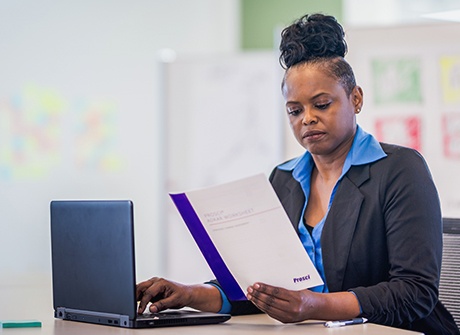

After more than a year of remote work, many organizations are planning return-to-the-workplace changes—but most aren’t returning to business as they knew it before the pandemic. In fact, smart organizations are seizing this unique opportunity to re-imagine and optimize their organizations.
MANAGING THE CHANGE TO HYBRID WORKPLACES
Now is the time for change management practitioners to plan for return-to-the-workplace changes. The key is to identify the work that needs to return to the office, which will inform who must return and in what capacity. What aspects does your organization need to change to accommodate your workplace of the future? What is important and what is not?
Applying an Adaptive Action framework can streamline your decision-making. Breaking down decisions by asking “What?” “Now what?” and “So what?” enables you to focus and plan effectively, even with limited information. The approach is straightforward. First, you note what you’re observing, then you draw conclusions, and then you take actions that address the implications.
Here are 10 areas to think through when developing plans to return to the workplace:
1. Space requirements
What? Identify the space needed for work returning to the workplace. This includes strategic workplace configuration, facilities management, re-imagining real estate, renovations, hoteling, home-office ergonomics, and social distancing and other safety protocols.
So what? Once you decide, you must align around the areas. Can you even have an office? Will you use temporary hoteling or assigned spaces? Don’t underestimate how people feel about their personal workspace. People have strong emotional reactions to not having their own place, not being able to hang up their pictures, and not having their own trash can. These reactions lead to resistance.
Now what? Establish where they are in their ADKAR journey. Anticipate the resistance and help them overcome their barriers. Think about how you will create policies and protocols. How will you enable the change and help people get people used to new ways of working?
2. Employee engagement
What? This involves actively managing employee engagement, finding ways to connect, team building through technology, and virtual facilitation.
So what? We all miss the daily interactions around the water cooler—those informal conversations that enable us to build relationships organically. We must be very intentional about creating ways to engage with those who are virtual and in hybrid working environments.
Now what? Create specific policies for building teams, connecting online before meetings, creating virtual get-togethers, and committing time to build relationships and find connections.
3. Expectation management
What? We must have clear expectations about work hours, availability, boundaries, flexible work policies, outcomes measurement, and goal setting.
So what? It’s critical to help people buy into the chosen approach now and then plan for resistance to return later. Desire on day one is not the same as desire on day 14 after the excitement wears off and people start to think, “Wow. I really liked being at home on Zoom in my slippers, and I hate sitting in traffic.” As change leaders, we must remember that the ADKAR Model is dynamic, and we will need to revisit Desire.
Now what? Communicate the options, boundaries and approaches to manage expectations about return-to-the-workplace changes. Planning for resistance up front, keeping communication lines open, and responding to issues will be critical.


4. Hybrid communications
What? This includes the strategy for a remote or hybrid workforce, creative communications, various virtual channels, on-screen protocol, and expectations around communications.
So what? Every organization now understands what they can and can’t do well remotely. How will this apply to the hybrid workplaces we’re creating?
Now what? Examples include being very intentional about communications in multiple channels, such as email, chat, Microsoft Teams and Slack. This means understanding “Zoom fatigue,” developing on-screen protocols, and getting creative—perhaps creating video updates for your teams every Friday. It is also important to help teams manage boundaries around communications because being at home means the workday can creep into evenings and weekends, causing burnout.
5. Protecting culture
What? This involves supporting and protecting culture, building new culture and connection remotely, developing new mindsets and attitudes, and building trust remotely.
So what? Think about your culture, who you are as an organization, and where your issues are. If you are a collaborative, trusting culture that builds relationships, you can still do that in a virtual or hybrid environment. If you are siloed or lacking trust, remote work will exacerbate that.
Now what? Leaders set the tone, so they must model the behavior they want to see. How will you continue to live the organization’s values in remote and hybrid workplaces?
6. Technology requirements
What? This includes technology needs for virtual, in-person or hybrid workplaces, including home-office support, IT security and bandwidth.
So what? Having flexible technology has been a critical enabler for some organizations and a debilitating barrier for others. Which is it for your organization? Think through which technologies you need for the work that must be done, which systems have to improve, and what your employees need to be productive.
Now what? Thoughtfully planning and then supporting your team will ensure that they have the right tools, know how to use them, and have duplicates for home and office as needed. There’s nothing more frustrating than trying to do your job when you don’t have the tools to do it.
7. Managing shared spaces
What? This involves managing capacity maximums, square footage and shared spaces as needed.
So what? We must think about available space and the number of people allowed in each room. Policies and procedures for reserving conference rooms and open offices will also be necessary to pre-empt unwanted behaviors. You will also need to manage resistance to the new, hybrid-workplace policies.
Now what? What policies and procedures do you need, so you don’t exceed maximum capacity? How will you keep people from sitting in conference rooms all day? How will you communicate the new requirements and overcome objections?
8. Hybrid engagements
What? Some people will attend meetings in person while others attend online.
So what? If anyone is remote, you will need to manage the entire meeting as remote.
Now what? Unique hybrid technology must bridge the in-person/on-screen divide to ensure that the remote people remain engaged. How will you accommodate that?
9. Recruiting and hiring approaches
What? Recruiting for remote opportunities.
So what? Recruiting remotely offers greater access to talent pools, but the process requires virtual hiring and onboarding.
Now what? This is not just about online interviews. You must be very intentional about new employees coming on board and helping them feel connected to the organization, even when they’re not physically present. How do you enable that connection and competence?


10. Training facilitation
What? Rethink training, learning methods and delivery.
So what? Working in a hybrid work environment means training online, in person and both concurrently. Each approach requires a different skillset.
Now what? People will need to know how to facilitate virtual and in-person training with multiple screens and different kinds of software. How will you plan for that? What skills and support do they need? What needs to happen to make sure they will be successful?
RETURN-TO-THE-WORKPLACE PLANNING
Returning to the workplace will mean something different for every organization. Whether you’re going back to in-person work, staying completely virtual, or adopting a hybrid version of the two, you will need to be intentional about planning. Most importantly, don’t underestimate what a big change it’s going to be for people after a year or so of working from home. This is not just any change. It’s a rare opportunity to achieve greater productivity, access global talent, reduce waste, and offer work-life balance to your valued employees.
This article is originally published on Prosci via Debbie McCarthy.
MARG is a leading Training & Consulting firm with over 200+ clients and more than 150,000 trained professionals. MARG is the primary authorized affiliate of Prosci Inc. in India. For more information contact a MARG learning partner at [email protected].